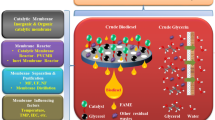Abstract
Three traditional methods for the refining step in biodiesel production were compared: (i) washing with distilled water; (ii) washing with acid (HCl); and (3) dissolving and extracting in a solvent (hexane or petroleum ether) and then washing with distilled water. Biodiesel with a high purity (97.5%) could be obtained by all three methods, but serious emulsification occurred during the refining processes, which led to high refining losses. A novel refining method was developed by using hollow fiber membrane extraction, and polysulfone was selected as the most suitable membrane. This process effectively avoided emulsification during refining and decreased the refining loss. The purity of the biodiesel obtained was about 99%; and other properties, such as density, kinematic viscosity, water content, and acid value, conformed to the standards.
Similar content being viewed by others
References
Ma, F., and M.A. Hanna, Biodiesel Production: A Review, Bioresour. Technol. 70:1–15 (1999).
Vicente, G., M. Martinez, and J. Aracil, Integrated Biodiesel Production: A Comparison of Different Homogeneous Catalysts Systems, Bioresour. Technol. 92:297–305 (2004).
Freedman, B., and E.H. Pryde, Variables Affecting the Yields of Fatty Esters from Transesterified Vegetable Oils, J. Am. Oil Chem. Soc. 61:1638–1643 (1984).
Mohamad, I.A., and O.A. Ali, Experimental Evaluation of the Transesterification of Waste Palm Oil into Biodiesel, Bioresour. Technol. 85:253–256 (2002).
Freedman, B., R.O. Butterfied, and E.H. Pryde, Transesterificaton Kinetics of Soybean Oil, J. Am. Oil Chem. Soc. 63:1375–1380 (1986).
Dorado, M.P., E. Ballesteros, and F.J. Lopez, Optimization of Alkali-Catalyzed Transesterification Brassica carinata Oil for Biodiesel Production, Energy Fuels 18:77–83 (2004).
Antolin, G., F.V. Tinaut, Y. Briceno, V. Castano, C. Perez, and A.I. Ramirez, Optimisation of Biodisel Production by Sunflower Oil Transesterification, Bioresour. Technol. 83:111–114 (2002).
Encinar, J.M., J.F. Gonzalez, J.J. Rodriguez, and A. Tejedor, Biodiesel Fuels from Vegetable Oils: Transesterification of Cynara cardunculus L. Oils with Ethanol, Energy Fuels 16:443–450 (2002).
Karaosmanoglu, F., K.B. Cigizoglu, M. Tuter, and S. Ertekin, Investigation of the Refining Step of Biodiesel Production, Ibid. 10:890–895 (1996).
A.I.D. Fuel Oils Ltd., Bio Diesel, http://www.aidfuelois.co.uk/h&s/biodiesel.htm (accessed February 2004).
Gabelman, A., and S.T. Hwang, Hollow Fiber Membrane Contactors, J. Membr. Sci. 159:61–106 (1999).
Author information
Authors and Affiliations
Corresponding author
About this article
Cite this article
He, H.Y., Guo, X. & Zhu, S.L. Comparison of membrane extraction with traditional extraction methods for biodiesel production. J Amer Oil Chem Soc 83, 457–460 (2006). https://doi.org/10.1007/s11746-006-1226-7
Received:
Accepted:
Issue Date:
DOI: https://doi.org/10.1007/s11746-006-1226-7




